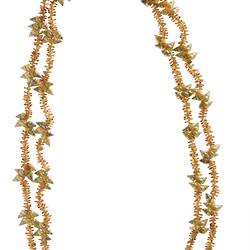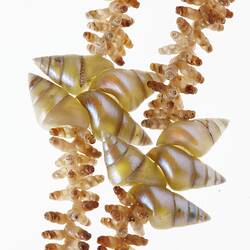Summary
Sarah Mansell made this shell necklace which features blue-green mother-of-pearl maireener shells from Big Dog Island. These are collected from seaweed by wading knee-deep in the water during a spring tide. The smaller driedmes shells were collected from Bung's beach on Cape Barren Island.
Aboriginal Elder Aunty Dorothy Murray, who is a descendent of Sarah Mansell, speaks of the long tradition of shell-necklace making in her family and her memories of shell collecting with her Elders as a child;
'Well, it seems to be very strong with my family, the Mansell women. Cos there was four sisters that used to do it, that did it. Then, their cousins did it. So it stayed in that family more than the other people. Because there was my granny, her three sisters, then there was Gladys and Madge, which is Nola's aunties. Cos they're from my grandmother's family too. And plus, the other one, Sarah Mansell, she was related to them. My family too.
We used to carry the loads for them. When we arrived at the place where they was gonna collect their shells, we were not allowed on the beach before they were. And we went round to cut the sticks for them to make a fire, the boil the billy for their cup of tea, because they'd take their food with them. They would have damper and limpets or periwinkles. So that was their day's outing.' Aunty Dorothy Murray, 2010
Pakana (Tasmanian Aboriginal) women would collect shells with their Elders from a young age and watch them string them at home by the light of a kerosene lamp. Through this careful attention to the work of their Elders, the tradition of creating beautiful shell necklaces passed from one generation of women to the next.
Making shell necklaces has always been a craft practiced by women only, the shells sourced from stretches of the coast of mainland Tasmania and the beaches of the Bass Strait islands. Knowledge of the best locations and the seasons to collect the shells is held by the women who carefully comb the coast for the valuable shells. Cape Barren Island has a long history of women stringers, such as Sarah Mansell, and the practice continues to be learnt and taught to new generations of women working with shell.
Physical Description
Single strand shell necklace made of alternate bands of green pearly coloured mariners and brown coloured driedmes drilled and threaded onto twine.
Significance
In 2010, the Tasmanian Museum and Art Gallery capitalised on the success of the tayenebe project (which celebrated and fostered the continuance of traditional Tasmanian basket-making practices) by launching a project to revitalise the Tasmanian Aboriginal tradition of shell-stinging. This project, called Luna tunapri (women's knowledge') succeeded in bringing Tasmanian Aboriginal women together to explore the history of important cultural practices, document and share stories of people, places and times and to pass important teachings on to the next generation of cultural custodians.
Luna tunapri (women's knowledge') has resulted in the exhibition kanalaritja: An Unbroken String, which will extensively tour Australia from 2017 to 2019.
As well as showcasing the beautiful craft of historical and contemporary Tasmanian Aboriginal stringers, kanalaritja: An Unbroken String, explores the ways this intricate practice has survived and flourished, despite attempts to decimate the Aboriginal peoples of Tasmania and their unique culture.
The co-curators of the brilliant exhibition kanalaritja: An Unbroken String, Pakana women Zoe Rimmer and Liz Tew, explain the cultural importance of shell stringing for their peoples;
'Shell stringing is our longest continued cultural practice, a practice which not only withstood invasion and colonisation but continued throughout the Black War and during the time our Ancestors were incarcerated in government missions at Wybalenna on Flinders Island and Putalina (Oyster Cove), south of Hobart.
Today, our connection to Country, cultural knowledge of shell resources, the weather patterns and the tides remains within our community, particularly our shell stringers. We proudly continue this unique Pakana tradition and honour the fortitude of our Ancestors who ensured its survival.' Zoe Rimmer and Liz Tew, 2016.
References
Message Stick, Dorothy Murray, 2010, Viewed 1 September 2017.
http://www.abc.net.au/tv/messagestick/stories/s2955870.htm
Rimmer, Z, Tew, L. 2016, kanalaritja: An Unbroken String pp. 12-13, Tasmanian Museum and Art Gallery.
More Information
-
Object/Medium
Ornament, neck
-
Maker
-
Locality
Cape Barren Island, Bass Strait Islands, Tasmania, Australia
-
Date Produced
-
Collector
-
Object Measurements
470 mm (Length), 130 mm (Width), 20 mm (Height)
-
Classification
-
Date Made
-
Maker
-
Clan/Language Group
-
Place Made
-
Indigenous Region
-
Keywords
-
Collection Names
-
Type of item
-
Discipline
-
Category
-
Collecting Areas


